Development of municipal formations. Рубрика в журнале - Economic and Social Changes: Facts, Trends, Forecast
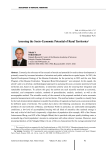
Assessing the socio-economic potential of rural territories
Статья научная
Currently, the relevance of the research of trends and potential for rural territory development is primarily caused by increased attention of scientists and public authorities to spatial topics. In 2019, the Spatial Development Strategy of the Russian Federation for the period up to 2025 and the new State Program of the Russian Federation “Integrated Rural Development” were adopted. In this regard, the article's aim is to develop a methodological approach to assessing the socio-economic potential of rural territories and, based on its approbation, to determine priority areas for ensuring their integrated and sustainable development. To achieve this goal, the authors use such scientific methods as economic, statistical, and comparative analysis, methods of generalization, analysis, synthesis, as well as the monographic method. The scientific novelty of the research is the proposed method of socio-economic potential measurement (with scoring) of rural territories. This method makes it possible to classify them by the level of potential development to justify the priorities of regional and local socio-economic policies for different types of territories. The authors have drawn the following conclusions: key development problems of rural territories of Russia, and Russian North in particular, are unfavorable demographic conditions; a low level of accomplished housing with all kinds of amenities (the national average is that only a third of the Fund is improved); a high share of population (for example, 40% of the Nenets Autonomous Okrug, and 45% of the Vologda Oblast) that is provided with poor-quality drinking water; a noticeable lag of rural population's income in comparison with urban citizens' incomes. Moreover, most municipal districts of the Vologda Oblast (14 out of 26) are characterized by the average potential level of their rural territories. The materials of the article can be used by the authorities and serve as a basis for further scientific research on this topic.
Бесплатно
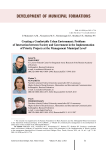
Статья научная
The federal program on the formation of comfortable urban environment was initiated in Russia in 2017. Its aim is to improve local and public territories. The program implies the active involvement of citizens, which is taken into account in the Urban Environment Quality Index. On the basis of an empirical study, conducted using mass survey and expert interview methods in the towns of the Arkhangelsk Oblast, the authors analyze a degree of civic participation of residents in the implementation of projects to create a comfortable urban environment and assess the efficiency of existing mechanisms of interaction between society and government. We assume the theoretical provision that a social activity is the citizens’ work to transform the environment, carried out under the influence of external and internal factors. External factors include activities of municipal authorities to inform town residents about the program for creating a comfortable urban environment and to involve them in the implementation of projects. Internal factors are citizens’ personal interest and their meaningful participation in the program. The results of the sociological survey indicate a high potential for citizens’ social activity, which is a necessary condition for effective interaction between government and society and a successful implementation of the program. However, practical participation of urban residents remains weak. The main reasons are the lack of citizens’ awareness about the implemented program, the lack of clear ways of interaction between government and society, as well as an understanding of the program’s fundamental principles, which, in turn, leads to passivity and distrust toward the authorities. The authors conclude that, in order to increase civic engagement, we need a system of measures, which would allow adjusting the existing communication means between government and society and increasing the effectiveness of the program on the formation of a comfortable urban environment.
Бесплатно
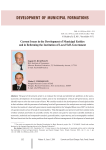
Статья научная
The goal of the present article is to evaluate the trends and identify key problems in the socio-economic development of municipal entities and in the development of local self-government, and to identify ways to solve the most acute of them. We consider trends in the development of municipal entities in their relation with the processes of reforming local self-government; the analysis uses not only statistics, but also the results of a local self-government monitoring held in the Vologda Oblast since 2007 in the form of a questionnaire survey of heads of municipalities. This distinguishes our present work from similar works of other scholars and forms its scientific novelty. To achieve our goal we used such scientific methods as economic, statistical and comparative analysis, generalization, expert survey, and a monographic method. We have found out that the main problems that impede efficient management of development of municipal entities are as follows: flaws in the legislation regulating the development of local self-government; lack of own revenue sources and insufficient financial support from the state; low efficiency of interaction with public authorities; lack of complete and reliable information on the socio-economic development of the municipality; non-involvement of the local population; limited powers of local self-government bodies in the sphere of economic development of the territory...
Бесплатно
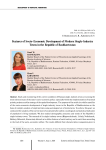
Статья научная
Study and monitoring of the current condition of Russian single-industry towns are among the most relevant issues of the state’s socio-economic policy: especially within the implementation of national priority projects and the strategy of the spatial development. The purpose of the article is to define specifics of the socio-economic development of single-industry towns in the Republic of Bashkortostan on the basis of complex analysis of empirical data using sociological set of instruments. To achieve this goal, we conducted the analysis of the current state of social and labor sphere, sociological and statistical indicators of population’s living standards. We also studied demographic processes and trends of the Republic’s single-industry towns. The research of six single-industry towns (Blagoveshchensk, Uchaly, Neftekamsk, Belebey, Beloretsk, Kumertau) allowed us to define features of each territory and to rank them according to the level of the socio-economic welfare. The results differed from characteristics (categories) given in the latest list of Russian single-industry towns provided by the Ministry of Economic Development of the Russian Federation. According to updated data, only Neftekamsk could be called a town with the stable socio-economic situation. Blagoveshchensk, Uchaly, Belebey are at the risk of the socio-economic situation worsening. Beloretsk and Kumertau are among towns with the most difficult socio-economic conditions. Towns with high business potential were identified (Belebey, Beloretsk, Blagoveshchensk). However, this potential is usually implemented in the informal sector of the economy, which significantly worsenspopulation’ssocialwell-being. Businesspotentialofothertowns(Uchaly, Neftekamsk, Kumertau) is very low. In Uchaly and Kumertau, there are almost no employment alternatives: it defines citizens’ heavy dependence on the town-forming enterprise. At the same time, municipal authorities do not have an opportunity to change the socio-economic situation in towns. Usage of sociological instruments in the course of the research allowed us to reveal internal factors and features of single-industry towns’ development, which are manifested in the population’s life attitudes and social well-being, but they are not reflected by statistical indicators. Developed methodology might be used for complex studies of other Russian single-industry towns and the search for efficient strategy of their modernization.
Бесплатно
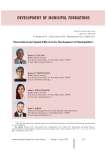
Hierarchical and spatial effects in the development of municipalities
Статья научная
. Thepaperpresentstheresultsofanalysisoftheinfluenceofseparatelevelsofpublicadministration hierarchy (regional, municipal) and neighboring territories on the indicators of socio-economic condition of municipal entities. The study was conducted in the context of 300 municipal entities of six subjects of the Russian Federation. The hierarchical and spatial effects were determined in several stages. The impact of separate administration levels on the results obtained by municipal entities was assessed with the use of hierarchical linear modeling (HLM), which is applied in other scientific fields to analyze group and inter-group relations. The connectedness of municipalities was evaluated with the use of spatial statistics methods (Moran Index). The analysis has shown that both vertical and horizontal connections of municipal entities are important. They determine spatial and hierarchical effects. Assessing the change in a given indicator, taking into account both the internal potential and the existing external horizontal and vertical links simultaneously is the most difficult but necessary step in the formation of management decisions regarding municipal entities...
Бесплатно
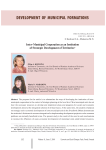
Inter-municipal cooperation as an institution of strategic development of territories
Статья научная
The purpose for the article is to substantiate the ways of developing the institution of inter-municipal cooperation in the context of strategic planning at the local level. Most municipal units do not have the necessary resources to develop and implement plans and programs for social and economic development aimed at the integrated solution of all local issues. At the same time, the analysis of projects on strategic socio-economic development of some municipal units in the Sverdlovsk Oblast demonstrates the territories’ disinterest in resource integration for implementing development projects to solve common problems on mutually beneficial terms. The present study is the result of the need to seek mechanisms to increase the efficiency of socio-economic development of municipal units amid limited resources. The authors propose a methodical basis of the multicomponent analysis of strategic development factors based on sectoral and territorial cooperation of municipal units...
Бесплатно
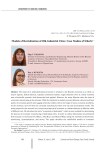
Models of revitalization of old-industrial cities: case studies of Siberia
Статья научная
The study of re-industrialization processes in relation to the Russian economy as a whole, to macro-regions, federal districts, separate constituent entities, single-industry towns is a fairly common area of scientific research, both theoretical and applied. However, for many Siberian cities the issue of economic restructuring is also relevant. With the transition to market economy Siberian cities turned from points of economic growth into lagging territorial entities with a full range of socio-economic problems. At the moment, most of them are currently searching for their own way and development model. The main purpose for the research is to assess the prospects of economic re-industrialization in Siberian cities of different size. We introduce the term “economic revitalization” which is more suitable for determining the process of economic restructuring of individual cities. In order to collect information we performed field research in the Kemerovo Oblast, Altai Krai, and Irkutsk Oblast using the methods of observation, monitoring, systematization, and survey...
Бесплатно
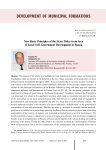
New basic principles of the state policy in an area of local self-government development in Russia
Статья научная
The purpose of the article is to highlight the most important economic, legal, and institutional foundations which are advised to be included in the new “Basic principles of national policy on local self-government development through to 2030”. It was concluded that it was a late decision to prepare a new version of the Principles which caused significant difficulties in the practical implementation of reforms in the municipal environment of the Russian Federation along with many gaps and numerous subsequent additions and amendments in Federal Law no. 131-FZ “On the general principles of the organization of local self-government in the Russian Federation”. Nowadays, update of the Principles is very important. It is related to five significant novations which make us reexamine aims and instruments of the state policy in the local self-government area. The first one is a global trend of management decentralization that noticeably strengthens the role of a local link of socio-economic systems. The second important novation is the relevance of a task to implement “federalization” of the government’s management of local self-government. The third novation is a necessity to naturally include local self-government in a unified vertical of strategic planning: its efficient functioning takes a crucial part in providing sustainability of the country, its regions, and municipal territories’ socio-economic development. The fourth demanded novation is expediency to secure a formula, or a principle, that would allow stopping an infinite series of reorganizations of Russian self-government together with various dividing and unifying processes in this sphere. Finally, the fifth novation is a necessity to finish the transformation of Russian local self-government from a low-level component of the administrative and command system into a socio-economic institution that naturally combines features of social authority and the beginning of a modern civil society and practically implements an institutional principle of “independent solution of local issues by people”.
Бесплатно
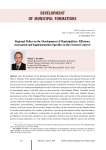
Статья научная
After the adoption of the Strategy for Spatial Development of the Russian Federation until 2025 in February 2019, special importance was attached to the issues concerning the formation of the coherent system of the RF entity’s regional policy on the development of municipalities, which takes into account socio-economic and geographical features of different territories. In this regard, the goal of this article is to develop methodological tools for efficiency assessment and for analyzing the specifics of interregional policy in the RF entity (on the materials of the Vologda Oblast). Scientific novelty of the research consists, first, in the fact that it uses expert opinions, which were obtained during a questionnaire survey of the Vologda Oblast municipalities heads, and second, in the analysis based on our own criteria of spatial (territorial) aspects reflection in strategies for development of constituent entities within the Northwestern Federal District. The research uses methods such as analysis, synthesis, comparison, generalization, methodological tools based on economic and statistical, comparative analysis, and expert survey. We reveal that, despite the efforts of state authorities of the Vologda Oblast to develop municipalities, the number of problems, concerning interregional policy implementation, still exist. They are: insufficient consideration of specifics and features of certain municipalities’ development; bureaucratic obstacles in the cooperation between state and local authorities; limited powers of local authorities, etc. The results of the conducted research might be used in the activities of state authorities of the Russian Federation entities. Also, the research might serve as the foundation for further scientific studies on the ways to improve the forms, methods, and tools of the interregional policy implementation.
Бесплатно
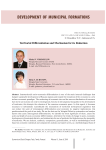
Territorial differentiation and mechanism for its reduction
Статья научная
Interterritorial socio-economic differentiation is one of the main internal challenges that hamper sustainable development of Russian regions and impede the transition of the economy to a new techno-economic paradigm. The weakening of economic ties and the uneven distribution of resources have led to an increase not only in interregional, but also in intraregional inequality in the development of territories; this disrupts the cohesion of the common economic space. In this regard, it becomes necessary to substantiate scientifically the mechanism of territorial development regulation that can reduce the scale of intraregional differentiation and overcome its negative implications; this predetermined the goal of our study. We use the data on the Vologda Oblast to systematize and analyze factors that cause intraregional differentiation; we identify the most significant of them, assess the scale and depth of socio-economic differentiation, determine the trends of change in socio-economic development of municipal districts, and substantiate the use of methods that help decrease the inequality of territories...
Бесплатно
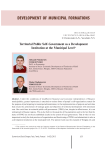
Territorial public self-government as a development institution at the municipal level
Статья научная
Under the conditions of insufficient financial and economic independence of Russia’s municipalities, greater importance is attached to various forms of people’s self-organization created for the purpose of participating in municipal administration, in the implementation of projects and activities that ensure the achievement of strategic goals and objectives of territorial development with minimum cost. One such form is territorial public self-government (TPSG); but, despite its effectiveness, it is not widespread in Russian regions. This is due both to the passivity of the population and to the fact that the status of TPSG has not been established clearly in the system of local government. That is why it is very important to study the best practices of organization and functioning of TPSG and substantiate its role as a development institution at the municipal level. The present work uses the example of Vologda city and several RF subjects to show that TPSG can solve many local issues (in the sphere of social protection, improvement of territories, promotion of comfortable living, etc.)...
Бесплатно
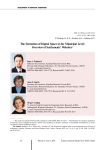
The formation of digital space at the municipal level: overview of settlements' websites
Статья научная
The formation of digital economy and transition to electronic government impose qualitatively different demands to authorities' presence on the Internet. Local authorities are not an exception here. Due to modest financial capabilities of many municipalities, their websites, objectively, cannot match the level of federal and regional web portals. The necessity to meet modern requirements implies the search for acceptable ways to be present online. The article attempts to determine the current state of spatial distribution of municipal authorities' digital involvement on the settlement level. To achieve it, we revealed the ways of being present on the Internet, checked the availability of connections between websites of municipalities, gathered information characterizing disclosure of information about dynamics of municipal institution development, identified additional Internet communication channels, and built cartograms. The research includes 313 urban and rural settlements in the Republic of Karelia, the Arkhangelsk, Vologda, Leningrad, and Murmansk oblasts. The results of the study indicate that the digital space of this territory at the municipal level is almost completely formed and has a low degree of mutual integration of its Internet resources. It is shown that the most popular way of providing information about the settlement on the Internet - website - is not the best. It is revealed that local governments rarely use social media as an auxiliary or alternative channel of Internet communication with local residents. It is noted that the majority of settlements orientate toward practices used in settlements of their municipal district, while creating and maintaining webpages without borrowing the experience of neighboring districts and regions. The results of this study might be used for qualitative improvement of municipalities' activities conducted online and formation of e-government on regional and municipal levels.
Бесплатно
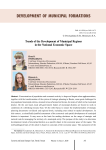
Trends of the development of municipal regions in the national economic space
Статья научная
Concentration of population and economic activity in large and largest urban agglomerations, together with the transformation of the system of strategic planning in Russia, cause great challenges for less populated municipal entities, situated in less urbanized territories, the main of which is the municipal district. On the one hand, local self-government bodies of municipal districts are forced to work in conditions of a shrinking resource base. On the other hand, to ensure the implementation of strategic planning documents on federal and regional levels, including ones related to spatial development. In this context, a scientifically justified assessment of the economic and spatial development of municipal districts is important. It may serve as the basis for making decisions on the usage of strategic and tactical tools for managing the territory of a municipal entity. The purpose of the study is to determine development trends of municipal districts as a specific object in the economic space of the region. The methodological basis of the article is based on concepts of the economic space. The assessment of the economic and spatial development was based on groups of indicators that reflect three parameters of the economic space: intensity, the development of the physical basis, and connectivity. On the basis of the results of calculating the presence indices and analyzing time series, a generalized score of the economic and spatial development of municipal districts is given. According to it, the types of trends, depending on the impact of the economic space of the region (constructive or destructive), are identified. Approbation of the methodology on the example of municipal districts of the Chelyabinsk Oblast showed that urban areas have a significant impact on the economic space of the region in the field of agricultural production, despite the industrial specialization of the region; it confirmed the trend of movement of labor and capital into urban districts; allowed stating negative dynamics of the development of physical basis of the economic space and the unsatisfactory situation in terms of the connectivity of the economic space. The analysis made it possible to formulate four directions of the economic and spatial development of municipal districts. It may become the basis of tactical and strategic tools for regional and municipal management.
Бесплатно
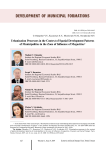
Статья научная
In the modern world, urbanization processes have become global and comprehensive. The federal law on regional policy “Fundamentals of the state policy of regional development in the Russian Federation for the period up to 2025” points out that the development of agglomerations is the most important condition for ensuring the competitiveness of the economy of the Russian regions and for providing economic growth and technological breakthrough. It can be stated that the significant role of the development of megacities as drivers of national economic growth is officially declared at the federal level of management of socio-economic development of territories. Due to the presence of various modifications of the organization of the economic space of the global economy in recent years, it becomes relevant to find new directions of scientific fundamental and applied research, the subject of which should be the socio-economic mechanisms of functioning of megacities and urban agglomerations formed on their basis, as well as the study of their impact on the municipal, regional, national and world economy in the context of globalization. In order to achieve a high degree of effectiveness in applying the experience of the United States, Western and Eastern Europe in our country, it is necessary to interpret the results of international activities in a certain context while maintaining the main target parameters. International processes of urbanization in the Russian practice are undergoing significant changes and are implemented in the form of suburbanization, a slightly different interpretation of the Western experience. Some of the results of the analysis of the activity of agglomeration movement in the Russian and international practice show that our country is lagging behind other countries, which is reflected in the presence of an insufficient number of municipalities that are larger and more populous then agglomerations: conurbations and others. We see the most important task of further research in studying the theory of urbanization and the processes of spatial and socio-economic development occurring in the territory of municipalities adjacent to the boundaries of megacities.
Бесплатно

